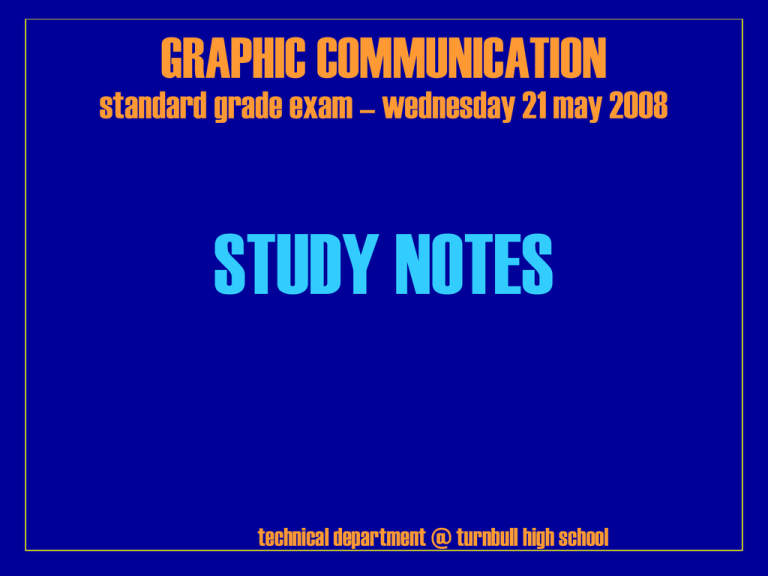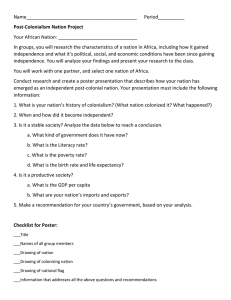presentations which describe all the topics you learned in class
advertisement

GRAPHIC COMMUNICATION standard grade exam – wednesday 21 may 2008 STUDY NOTES technical department @ turnbull high school INTRODUCTION . . . . . . . . Your teachers in the Technical Department have put together this presentation in an attempt to ensure you stand the best chance of reaching your full potential in the Graphic Communication exam this summer. The presentation is full of tips regards how to study for the Graphics exam plus plenty of useful advice which may also come in handy for your other subjects. Things to look out for on the disc are : presentations which describe all the topics you learned in class; plenty of Past Papers which show you the level you need to achieve; answers to Past Papers which let you check how well you are doing; 2003 Credit Answers which show how all the drawings were constructed. You will really do yourself a lot of good if you follow the advice offered here and, most importantly, put it into practice. Good Luck. CONTENTS . . . . . . . . GENERAL STUDY HINTS STUDY HINTS FOR GRAPHICS KNOWLEDGE & INTERPRETATION – what to expect DRAWING ABILITIES – what to expect EXAM TECHNIQUE USEFUL PRESENTATIONS – including Past Papers with answers GENERAL STUDY HINTS Past Papers. We have included a whole series of them – with answers in this CD. These are an excellent way of working out if you have the right level of understanding and familiarising yourself with the layout of the questions and the structure of the paper. Study Timetable. Work out a realistic amount that you will be able to devote to your studies, write up a plan and stick to it with determination. Only break the plan if completely unavoidable. Study little and often. 20-30 minute blocks repeated regularly over a lot of weeks are much more successful than a couple of days solid study immediately before the exam. A proven fact ! Use your course notes. Make sure you have all of the notes that you used in class. Do not leave any folders in class which could be used for revision. A good study environment. Get rid of clutter and distractions from the place where you are going to do your studying. This will help maintain your focus. Remember to relax. You will actually get more useful revision done if you make sure you switch off from it in between times. Make time for your usual pastimes. STUDY HINTS FOR GRAPHICS What are the bankers ? There will be certain topics which are more likely to come up than others. You will get a good impression of which ones from looking at as many past papers as you can. Your teacher will give you some past papers, others are available commercially. There are also some very good clues on this CD. Get the right equipment. To study properly and fully, you will need a basic set of drawing instruments. These should be relatively easy to get. If you have any difficulty, speak to your teacher. Revision Booklets. You were given revision booklets near the end of the course. Everything which could come up in the exam is in these booklets. If you get familiar with them, you will be well prepared. When and where. Make absolutely certain you know which two exams you are sitting – F/G or G/C. The exam will be held in the Graphics rooms on Wednesday 21 May. You will need to confirm with your teacher what room your exam is. It might NOT be the one you usually use for Graphics. Check in advance. Drawing Speed. You must get your drawing speed right up in order to get through all of the drawing questions. The ONLY way to do this is to draw, draw, draw. Even if you have done a drawing before, you will get benefit from doing it again. KNOWLEDGE & INTERPRETATION – what to expect You will be tested on your Knowledge & Interpretation in the Graphics exam by a series of questions which are a mixture of written and graphic. Typically, you will be given a symbol and asked what it represents. You may be shown a graph and asked to take some information from it. You may be shown an exploded view of a complicated assembly and asked some questions which would seek to find out if you could follow how the item is assembled. Here are some of the topics which may be tested in the Knowledge & Interpretation section ; Computer hardware / software Advantages / disadvantages of CAD Colour Theory Questions on Line Types Computer Generated 3D Models Computer Processes Graphs & Charts Signs & Symbols DRAWING ABILITIES – what to expect You will be tested on your Drawing Abilities in the Graphics exam by a series of questions which require you to draw the answer. Typically, you will be given a partially completed drawing in a specific drawing style. You will then have to complete the drawing/s as per the question. Here are some of the topics which may be tested in the Drawing Abilities section ; Isometrics with circles / curves Oblique Views Planometrics Orthographics One Point Perspective Two Point Perspective Square Pyramids Cones Developments True Shapes Sectional Views Assemblies Exploded Views EXAM TECHNIQUE Start with your banker. By the time you go into the exam you will know which question/s you are best at and most confident with. This is the question you should tackle first. Do not automatically do question 1 first. Read the question ! Sounds obvious but so many people simply scan the question without fully understanding what is being asked. TIP – read every question, figure out what is being asked then read the question again to check your initial thoughts were right. Then start to draw/answer. Check your answers. If you are lucky enough to finish with extra time, use it to the full. Go back over and read every question again and see if you have fully answered every question. Scrape every last mark. KI first ? Some people prefer to do all of the Knowledge & Interpretation questions first so they know exactly how much time they have left to devote to the drawing questions. What do you think ? Manage your time. You must make sure that you have a go at every question. Avoid getting bogged down and spending too much time on any single question. Try to spend at least 15 minutes on each question. Structure of the paper – In the last couple of years, the SQA have set the paper out so that there are four KI questions followed by five DA questions. Do you have a preferred order to tackle them ? Have you studied the past papers and worked out a plan ? USEFUL PRESENTATIONS Behind every orange box on this page is a presentation which you should watch. They will help you in a couple of ways. They could be used to confirm that your understanding of a topic is correct. They could also be used to guide you in the topics which you found difficult in class the first time round. They are designed as self help. Go through them slowly and if you still don’t get it, go back to your teacher as soon as possible. Our Past Paper section (with answers) will also prove to be a great help to you. CAD Isometric Intro CAG Iso Info Hardware Software Processes Iso Circles 3D Models Cylinders & Cones Oblique Intro Oblique Projection Sectional Views Planometric Intro Planometric - Method Exploded Views Orthographics Assemblies Orthographics Introduction One Point Perspective Two Point - Intro Square Pyramids Signs & Symbols Examples Method Line Types Graphs & Charts Click on a square . . . Colour Theory GRAPHIC COMMUNICATION standard grade – wednesday 25 may 2005 STUDY FINISHED NOTES good luck technical department @ turnbull high school




